AI-compatible sensors are devices or smart sensors that gather raw environmental data by incorporating AI. Thus, it processes, understands, and analyzes the data to make informed decisions & predictions. These AI sensors enable machines in AI systems to understand, adapt, and perform autonomously within complex situations across various fields like autonomous vehicles, healthcare, industrial automation, and smart homes. In IoT projects, various types of AI-compatible sensors play a crucial role by providing the raw data that AI algorithms need to perform different tasks. This article lists the top 5 AI-compatible sensors for IOT projects.
Top 5 AI Compatible Sensors for IOT Projects
AI-compatible sensors in IoT projects enable the analysis of the vast amounts of data generated by IoT devices. Thus, it allows smart analysis, analytical insights, immediate decision-making, and automatic actions devoid of human interference. This incorporation will create a more accurate, proactive, and efficient AIoT system. These systems can improve operational efficiency, security, cost reduction, etc.
In general, IOT projects utilize various types of AI-compatible sensors, including LiDAR, cameras, ultrasonic sensors, motion sensors, temperature sensors, and more advanced AI-based sensors equipped with onboard intelligence for context-aware operation. However, the top five AI-compatible sensors that stand out for IOT projects are the camera module, IMU sensor, environmental sensor, digital microphone, and heart rate & SpO2 sensor. These sensors have many benefits like versatility, data richness & how well they incorporate with AI models, particularly for smart analytics and edge computing.
Camera Module
A Camera module is an AI-compatible sensor that combines an image sensor and a dedicated AI accelerator or AI processor directly on the module. So this hardware performs AI tasks like image classification, object detection, and real-time analysis, exactly at the image source. AI camera sensors decrease the workload on the host device by processing data on board, understanding visual data very efficiently for applications from mobiles to industrial automation.
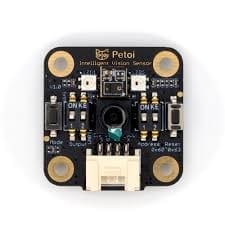
Camera Module
The key components of this module mainly include the image sensor, AI chip, memory, and firmware. The image sensor in this module captures the light, the next AI processor performs the AI computation, memory stores the data, and firmware manages the functions and operations of the camera and AI.
Thus, the image sensor in this module changes light into a signal. An AI chip is a special chip, often a DSP or dedicated AI engine, which processes these signals & runs AI models. The AI sensor examines and understands the data itself rather than sending raw images mainly to a host processor.
Examples: OV7670, Raspberry Pi Camera, Intel RealSense, Arducam.
Applications: Smart surveillance, autonomous vehicles, robotics, healthcare monitoring.
IMU Sensor
IMU sensors are essential, which track motion, rotation, and orientation by merging gyroscopes, magnetometers, and accelerometers to provide real-time data for a variety of applications. You can use sensor data in IoT projects alongside other sensors and process it with Node-RED and Grafana software to enhance systems, improve automation and safety, and enable smart decision-making.
IMU sensors consist of an accelerometer, a gyroscope, and a magnetometer. The accelerometer measures linear acceleration, the gyroscope detects rotational changes, and the magnetometer provides a magnetic heading reference.
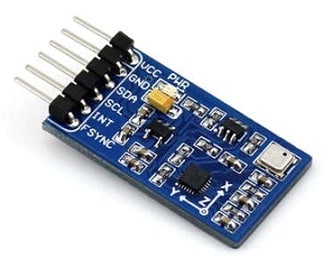
IMU Sensor
By frequently connecting IMUs with sensor fusion software, you can combine data from individual sensors to produce more precise and consistent measurements, delivering complete orientation and heading data. After collecting the data from the sensors, you can transmit it to the IoT platform, where you can store, analyze, and visualize it using InfluxDB and Grafana tools.
Environmental Sensor
Environmental sensors play a key role in monitoring various physical factors like humidity, temperature, soil conditions, and air quality by gathering real-time data and transmitting it into a central system for data analysis & action. Thus, these sensors allow smart environmental monitoring systems in smart agriculture, industrial processes, and smart cities by providing insights for enhanced public health, environmental security, and resource management through automated and remote monitoring.

Environmental Sensor in IoT Project
The working of environmental sensors follows as;
Sensors collect data by measuring key environmental parameters such as humidity, temperature, CO2 gas levels, and particulate matter like PM2.5, PM10, and soil moisture.
Next, the system wirelessly transmits the gathered data to a gateway or directly to the cloud using various communication protocols like LoRaWAN, Zigbee, or Wi-Fi.
Once transmitted, the data undergoes processing on local servers or cloud platforms, where it is analyzed for anomalies, insights, and trends related to ecological conditions.
This processed data provides information for users and can activate automated responses like air purifier activation or water treatment systems whenever pollutant levels go beyond thresholds.
Digital Microphone
Digital microphone sensors can detect sound in applications like security systems, voice-activated devices, and noise monitoring. Thus, these sensors are basic modules including a microphone, amplification circuit, and more advanced MEMS microphones, which change sound signals into electrical signals. They normally provide a digital output that changes from higher to lower whenever a sound threshold is crossed, with modifiable sensitivity with a potentiometer.
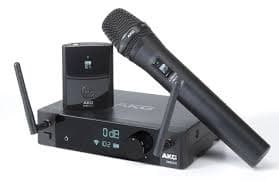
Digital Microphone
The digital microphone works as follows;
A microphone is frequently an electric condenser or a MEMS microphone that captures sound signals. After that, the sound signals can cause vibrations within the diaphragm of the microphone by changing its capacitance and producing a weak electrical signal. This signal can be amplified by onboard circuitry like an op amp.
An integral comparator changes the better analog signal into a digital output depending on a user-adjustable sensitivity threshold.
Finally, the sensor generates a HIGH signal whenever the sound is under the threshold & a LOW signal whenever it goes beyond it.
Microphone / Acoustic Sensors
Heart Rate & SpO2 Sensor
This is a device that measures two main signs non-invasively, like the heart rate and the oxygen percentage within your arterial blood. Thus, these two sensors use PPG (photoplethysmography) by producing different light wavelengths through the skin. It measures how much light can be absorbed through the blood to estimate the oxygen & pulse levels. Thus, it allows for remote health monitoring for people and patients with respiratory problems or those getting better from COVID-19 illnesses.
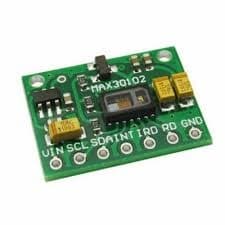
Heart Rate & SpO2 Sensor
The working of the Heart Rate & SpO2 Sensor follows as;
This sensor includes LEDs that emit infrared and red light into the fingertip. After that, a photodetector can measure the light that is supplied throughout the tissue.
The device notices the variations in the amount absorbed through pulsing blood volume.
Thus, it calculates the light absorption ratio between the two wavelengths to decide the oxygenated blood percentage. In addition, the changes in light absorption can also be used to detect the pulse to measure the heart rate.
Example IoT Projects using Top AI Sensors
The IoT project examples using Top AI Sensors are discussed below.
Camera Module in IOT Project Example
An AI camera module within an IoT project incorporates AI with a camera to allow on-device image analysis, like face recognition or object detection, in a connected system. The key components of this AI sensor-enabled IOT project include microcontrollers, development boards like ESP32-CAM, Raspberry Pi & Maixduino, and Realtek Amb82-Mini.
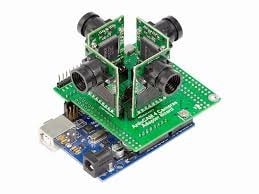
Camera Module in IOT Projects
The working of AI cameras within IoT follows as;
First, the camera module captures images/videos from its surroundings. Embedded AI algorithms analyze the captured data, running frequently on the microcontroller’s processor or a dedicated neural processing unit (NPU).
The AI identifies patterns, anomalies, or objects in the images, delivering real-time insights. Subsequently, the system transmits the processed data and generated insights over a network to user interfaces, cloud platforms, or IoT devices, enabling intelligent actions.
To decrease false alarms, it identifies illegal entry, tracks suspicious performance & differentiates between vehicles, people & other objects.
IMU Sensor Module in IoT Project Example
An IMU sensor module within IoT projects measures acceleration, magnetic field, and angular velocity of an object to decide its motion, position, and orientation. It includes different components like gyroscopes, magnetometers, and accelerometers, which track movement and control devices like robots and drones by enabling applications in smart homes, navigation systems & healthcare. Thus, these can be frequently connected with sensor fusion software for the understanding of precise data.
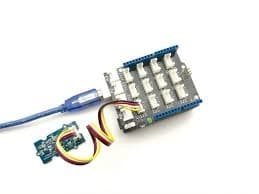
AI Compatible IMU Sensor in IoT Projects
The working of the IMU sensor module within IoT follows as;
An accelerometer measures the rate of change of velocity and linear acceleration, providing data on forces and movement along an object’s three axes.
Gyroscope detects rotating velocity (or) angular speed to measure how quickly an object is turning around its axes, like pitch, yaw & roll.
Magnetometer measures the limited magnetic field by providing a heading reference & helping to decide yaw more precisely, particularly whenever gravity alone isn’t adequate.
IMU modules are frequently combined with software to perform sensor fusion. Thus, it is a merging data process from these sensors to generate more precise and constant object’s orientation & attitude measurements.
Environmental Sensor in IoT Project Example
Environmental sensors within IoT projects gather real-time data on different factors like humidity, temperature, soil moisture, and air quality to check environmental changes & also support applications in smart cities, industrial operations, and agriculture. These sensors can frequently integrate with microcontrollers to wirelessly transmit data via protocols like LoRaWAN or Wi-Fi to a central platform for analysis, enhancing environmental conditions and public security.

Environmental Sensor in IoT Project
The working of the environmental sensor in the IoT project follows as;
Environmental sensors in the environment measure specific parameters. After that, the gathered data can be transmitted to a microcontroller.
The microcontroller transmits the data wirelessly with protocols to a cloud or central node platform.
This platform processes, analyzes & stores the data by allowing real-time monitoring & alerts generation.
The system can activate automated responses based on the analysis, like sending SMS alerts or activating purifiers for a high range of pollution.
Digital Microphone in IoT Project Example
Digital microphones are essential components within IoT projects to capture sound and allow voice interaction, audio monitoring & detection of sound-based events. They convert audio signals into digital data that IoT devices can process for various applications, including voice commands, audio-based security systems, and ambient noise analysis.
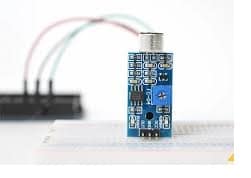
Digital Microphone Sensor in IoT Project
Key advantages of IoT mainly include low power consumption and high fidelity for battery-powered devices. In addition, it has some features like AAD (acoustic activity detection) to advance power management.
The working of the digital microphone in the IoT project follows as;
The diaphragm of the microphone vibrates in response to sound waves. The microphone converts vibrations into an electrical signal. The internal circuitry then processes this signal. Finally, the digital microphone transforms the analog electrical signal into digital data, which the IoT microcontroller can understand and utilize for further applications.
Heart Rate & SpO2 Sensor in IOT Project Example
The heart rate & SpO2 sensors like the MAX30102 or MAX30100 are incorporated with microcontrollers to allow remote health monitoring in real-time. Thus, these systems measure blood oxygen & pulse rate with pulse oximetry to send the data to a cloud platform over Wi-Fi & display it on a smartphone or dashboard for family members or doctors. So the main goal of this is to provide nonstop, automated health tracking & early potential issues detection by improving patient care & security.
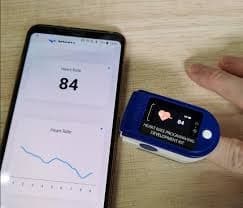
Heart Rate & SpO2 Sensor in IOT Project
Heart rate & SpO2 sensor working follows as;
These sensors work with a MAX3010x pulse oximeter module, which produces IR & red light through a finger. The sensor absorbs IR light from oxygenated blood, while it absorbs more red light from deoxygenated blood.
Using this data, the sensor measures the variation in absorption to estimate pulse rate and blood oxygen saturation. In IoT projects, the sensor sends this data to a microcontroller connected to Wi-Fi, which then transmits it to a mobile app or cloud service for real-time monitoring and analysis from anywhere.
Key Reasons to Use AI-Compliant Sensors in IoT Projects
AI-compatible sensors in IoT projects allow real-time data analysis, automate tasks, and make smart decision-making possible. Thus, by combining the analytical power of AI with IoT’s data collection abilities, systems can autonomously remove actionable insights for improved efficiency and outcomes across a variety of domains.
The main reasons to use Top 5 AI Compatible Sensors in IoT projects follow as;
- AI algorithms process and analyze the huge amounts of data generated by IoT sensors. Thus, identifies complex patterns & hidden insights that are hard for humans to notice.
- AI analyzes data from sensors to predict potential equipment issues by avoiding costly downtime within industrial applications.
- In addition, these AI-compatible sensors make real-time and intelligent decisions depending on incoming sensor data by allowing automated actions without human interference.
- AI algorithms understand and process sensor data. Thus, it leads to more effective and reliable outcomes to increase the accuracy of IoT systems.
- The top 5 AI compatible IoT sensors can adjust parameters and optimize processes in real-time by analyzing data streams & detecting patterns continuously.
- AI understands the collected sensor’s raw data by transforming it into significant information.
- It can analyze user behavior to identify unusual patterns by adding a protection layer to IoT systems.
This is an overview of the Top 5 AI compatible sensors used in IOT projects. Thus, these Top 5 AI compatible sensors provide the required real-time data for AI to examine and allow smart actions. These sensors provide significant input data when processed through AI algorithms in the cloud. So it leads to smart automation, smart decision-making, and predictive insights in IoT projects. Here is a question for you: What is IoT?